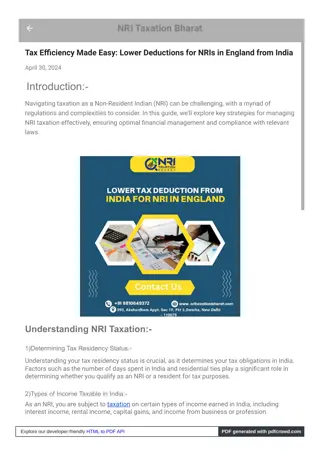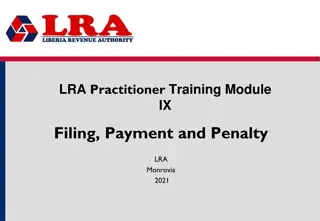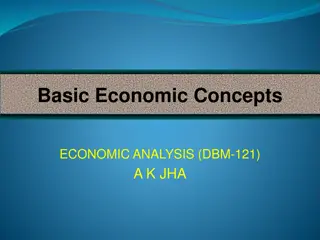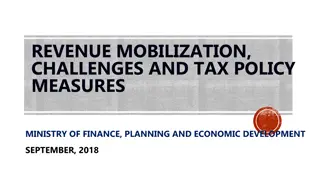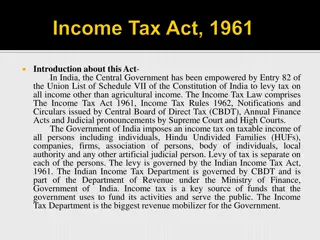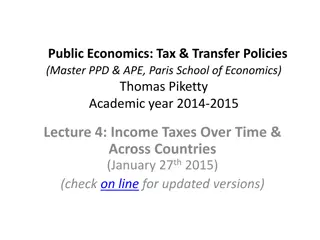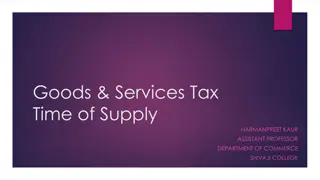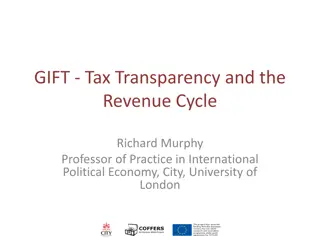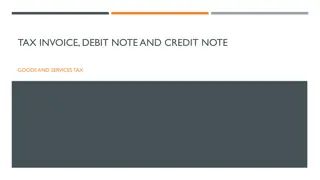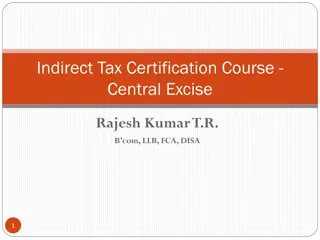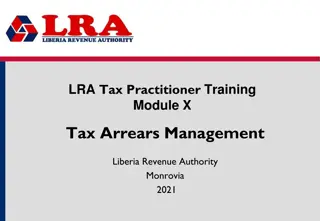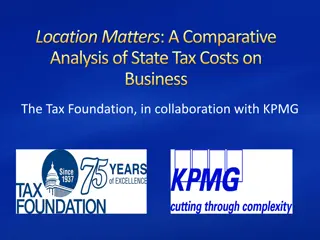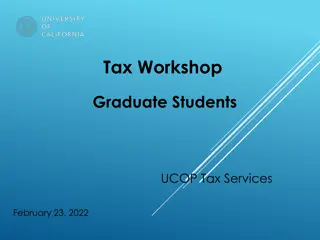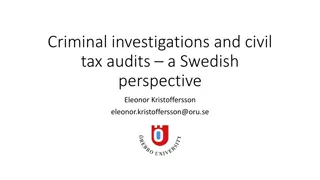Introduction to Goods and Service Tax in India
GST (Goods and Service Tax) is an indirect tax implemented in India to replace multiple indirect taxes. The Act came into effect on July 1, 2017, and is a comprehensive, destination-based tax levied on every value addition. Learn about the history of GST in India, dating back to recommendations made by Prime Minister Atal Bihari Vajpayee and the eventual implementation under different governments. Follow the timeline of events leading up to the adoption of GST, including the formation of committees, recommendations, and the journey towards nationwide implementation.
Uploaded on Apr 19, 2025 | 0 Views
Download Presentation

Please find below an Image/Link to download the presentation.
The content on the website is provided AS IS for your information and personal use only. It may not be sold, licensed, or shared on other websites without obtaining consent from the author.If you encounter any issues during the download, it is possible that the publisher has removed the file from their server.
You are allowed to download the files provided on this website for personal or commercial use, subject to the condition that they are used lawfully. All files are the property of their respective owners.
The content on the website is provided AS IS for your information and personal use only. It may not be sold, licensed, or shared on other websites without obtaining consent from the author.
E N D
Presentation Transcript
GST GOODS AND SERVICE TAX Dr. Ajit Ashte, Asst. Prof. Dept of Commerce, Shivaji Mahavidylaya, Omerga, Dist. Osmanabad Mobile 9423740707
WHAT IS GST? GST is an Indirect Tax which has replaced many Indirect Taxes in India. The Goods and Service Tax Act was passed in the Parliament on 29th March 2017. The Act came into effect on 1st July 2017; Goods & Services Tax Law in India is a comprehensive, multi-stage, destination-based tax that is levied on every value addition. Goods and Service Tax (GST) is an indirect tax levied on the supply of goods and services. This law has replaced many indirect tax laws that previously existed in India. GST is one indirect tax for the entire country.
HISTORY OF GST IN INDIA During 1999: Prime Minister Atal Bihari Vajpayee and his economic advisory panel, RBI governors namely I G Patel, Bimal Jalan and C Rangarajan. During 2000: On July 17, under Vajpayee leadership set up the Empowered Committee (EC) of State Finance Ministers to design a nationwide GST model.
During 2003: formed a task force to recommend tax reforms under Vijay Kelkar on the implementation of Fiscal Responsibility and Budget Management (FRBM) Act, 2013. During 2004: Vijay Kelkar recommends GST to replace the existing tax regime. Vajpayee headed BJP-led NDA government fell. During 2006: On 28 February, 2006, under Congress-led UPA government, new Finance Minister P Chidambaram continued work on the same. He proposed 1 April, 2010 as deadline for GST implementation throughout India.
During 2007: on May 10, 2007, a Joint Working Group on GST was formed, which submitted its report to the Empowered Committee (EC) on November 19, 2007. During 2008: On April 2008, Empowered Committee (EC) finalised its view on GST, submitted a report titled A model and roadmap for Goods and Services Tax (GST) in India . During 2009: The Empowered Committee (EC) released its First Discussion Paper (FDP) on GST in November, 2009, based on discussions within and between it and the Central Government. During 2010: Finance Minister P Chidambaram had announced that GST will be implemented from April, 2011. During 2011: In the Lok Sabha, the 115th Constitution Amendment Bill was introduced for the levy of GST on all goods and services across India.
During 2012: In 8th November, 2012, a Committee on GST Design was constituted, with members as officials of the Government of India, State Governments and the Empowered Committee was. During 2013: In August 2013, Standing Committee submitted its report on GST. In November 2013, EC rejected Government s proposal to include petroleum products under GST regime. During 2014: Under the leadership of Narendra Modi, the NDA government was re-elected into power. The new Finance Minister Arun Jaitley introduced the GST Bill (122th Constitution Amendment) in the Lok Sabha. During 2015: In February 2015, Jaitley set another deadline for GST implementation in India as 1 April 2016.
During 2016: On August 3, 2016, Rajya Sabha passed the GST. In 12 August 2016, when Assam became the first state to pass GST. On September 23, 2016, GST Network was formed, it is an online network designed to solve the problems and questions of consumers and businessmen. During 2017: On 16 January, 2017, Jaitley announces 1 July, 2017 as GST rollout deadline. During Midnight of 30 June, 2017 - GST came
GST TAX RATES INDIA 2019 under 0% GST Rate (No tax) Goods:- Unpacked foodgrains, fresh vegetables and fruits, unbranded atta, maida, besan, gur, milk, eggs, curd, lassi, unpacked paneer, unbranded natural honey, palmyra jaggery, all types of salt, fresh meat, fish, chicken, butter milk, cereal grains hulled, Jute, flour, bread, printed books, newspapers, bangles, handloom, etc;, Services:- Under GST, all hotels and lodges in India with tariff below Rs.1,000 are exempted
UNDER 5% GST RATE: Goods:- Apparel below Rs 1000, footwear below Rs 500, Sugar, tea, roasted coffee beans, edible oils, cream, skimmed milk powder, fish fillet, branded paneer, frozen vegetables, coffee, spices, pizza bread, rusk, sabudana, kerosene, coal, medicines, stent, lifeboats, Cashew nut, Cashew nut in shell, Raisin, Ice and snow, Biogas, Insulin, Agarbatti, Postage or revenue stamps, stamp-postmarks. Services:- Transport services (Railways, air transport), small restaurants.
UNDER 12% GST RATE: Goods:- Cell phones, Apparel above Rs 1000, sewing machine, umbrella, Ayurvedic medicines, tooth powder, Butter, ghee, almonds, fruit juice, packed coconut water, preparations of vegetables, fruits, nuts or other parts of plants including pickle, murabba, chutney, jam, jelly, namkeen, fruit juices, frozen meat products, dry fruits in packaged form, animal fat and sausage, cheese, colouring books, picture books, Ketchup & Sauces, All diagnostic kits and reagents, Exercise books and note books, Spectacles, corrective, Playing cards, chess board, carom board and other board games like ludo. Services:- Non-AC hotels, business class air ticket, State-run lotteries, fertilisers,.
UNDER 18% GST RATE: Goods:- Footwear above Rs.500, camera, speakers and monitors, Headgear and parts thereof, Trademarks, goodwill, software, Bidi Patta, Biscuits - All categories, flavoured refined sugar, pasta, cornflakes, pastries and cakes, preserved vegetables, jams, sauces, soups, ice cream, instant food mixes, mineral water, tissues, envelopes, tampons, note books, steel products, printed circuits, Kajal pencil sticks, Aluminium foil, Weighing Machinery [other than electric or electronic weighing machine]. Printers [other than multifunction printers], Electrical Transformer, CCTV, Optical Fiber, Bamboo furniture, Swimming pools and paddling pools, Curry paste; mayonnaise and salad dressings; mixed condiments and mixed seasonings. Services:- AC hotels that serve liquor, telecom services, IT services, branded garments and financial services, Room tariffs between Rs. 2,500 and Rs. 7,500, Restaurants inside five-star hotels.
UNDER 28% GST RATE: Goods:- Automobiles, Motorcycles, ATM, washing machine, shavers, hair clippers, Bidis, chewing gum, molasses, chocolate not containing cocoa, waffles and wafers coated with chocolate, pan masala, aerated water, paint, deodorants, shaving creams, after shave, hair shampoo, dye, sunscreen, wallpaper, ceramic tiles, water heater, dishwasher, weighing machine, vending machines, vacuum cleaner, aircraft for personal use. Services:- Cinema, 5-star hotels, Private-run lotteries authorised by the states, hotels with room tariffs above Rs 7,500, race club betting.
TYPES OF GST CGST - Central Goods and Services Tax. SGST - State Goods and Services Tax. IGST - Integrated Goods and Services Tax. UTGST - Union Territory Goods and Services Tax.


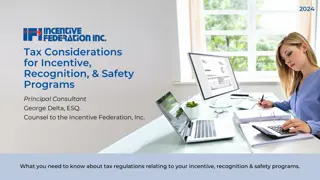
![Town of [Town Name] Real Estate Tax Rates and FY 2024 Budget Summary](/thumb/62211/town-of-town-name-real-estate-tax-rates-and-fy-2024-budget-summary.jpg)
